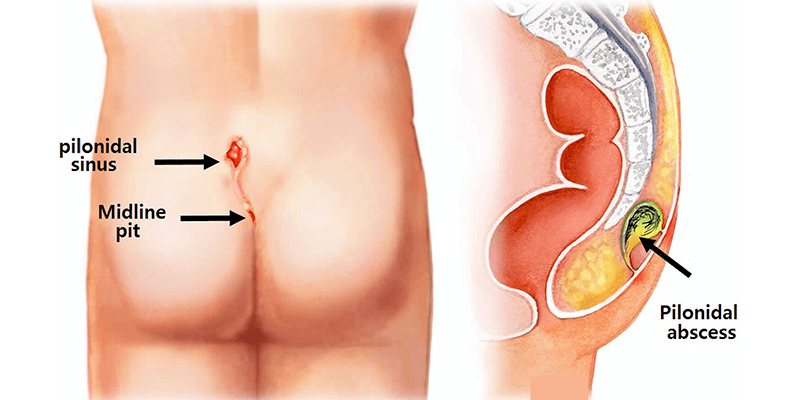What is Pilonidal Sinus?
A Pilonidal Sinus is a small tunnel or tract under the skin that usually develops in the cleft at the top of the buttocks. It may contain hair, debris, and skin, and can become infected, causing pain and discharge of pus or blood. It is more common in men, especially those who sit for long periods or have coarse body hair.
If left untreated, the sinus can turn into a chronic condition with recurrent infections, forming painful abscesses. To permanently resolve the issue, Pilonidal Sinus Excision surgery is often recommended.

Common Symptoms of Pilonidal Sinus
- Pain or swelling near the tailbone
- Redness or tenderness in the affected area
- Discharge of pus or blood from an opening in the skin
- Foul smell from the infected area
- Fever or fatigue (in case of severe infection)
- Difficulty sitting or walking due to discomfort
Causes and Risk Factors
- Ingrown hairs
- Prolonged sitting or friction in the buttocks region
- Excessive body hair and poor hygiene
- Obesity
- Sedentary lifestyle
- Trauma or irritation to the area
Pilonidal Sinus Excision Procedur
Pilonidal Sinus Excision is a surgical procedure performed to remove the sinus tract and all infected tissue to prevent recurrence. It can be done under local, spinal, or general anesthesia depending on the case severity.
Types of Surgical Treatments:
- Open Excision (Healing by Secondary Intention):
- The sinus is completely excised and the wound is left open to heal naturally over time.
- Regular dressing changes are required.
- Closed Excision (Primary Closure):
- After removing the sinus, the wound is stitched closed.
- Faster healing but higher risk of recurrence.
- Flap Surgery:
- Used for chronic or recurrent sinuses.
- The surgeon uses healthy tissue to cover the defect and reshape the area to reduce friction and recurrence.
- Laser Pilonidal Sinus Treatment (Minimally Invasive):
- Involves the use of a laser fiber to destroy the sinus tract.
- Less pain, faster recovery, and no stitches.
Prevention Tips
- Maintain proper hygiene of the buttock area
- Remove excess hair through laser or regular shaving
- Avoid prolonged sitting
- Wear loose, breathable clothing
- Keep the area dry and clean
- Regular physical activity to avoid obesity
Benefits of Pilonidal Sinus Surgery
- Permanent removal of infection and sinus tracts
- Reduced risk of recurrence with proper technique
- Relief from pain, swelling, and discharge
- Improved quality of life and mobility
- Quick recovery with minimally invasive options
Recovery and Aftercare
- Recovery time depends on the type of procedure (2–6 weeks typically)
- Patients are advised to avoid heavy physical activity for a few weeks
- Regular dressing and follow-ups are essential
- Maintain hygiene and hair removal post-surgery
